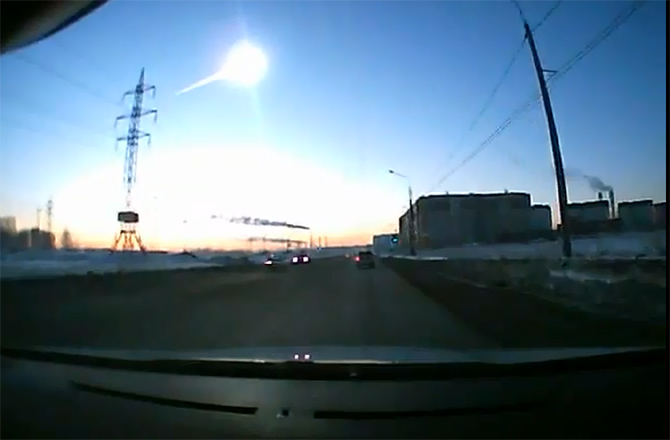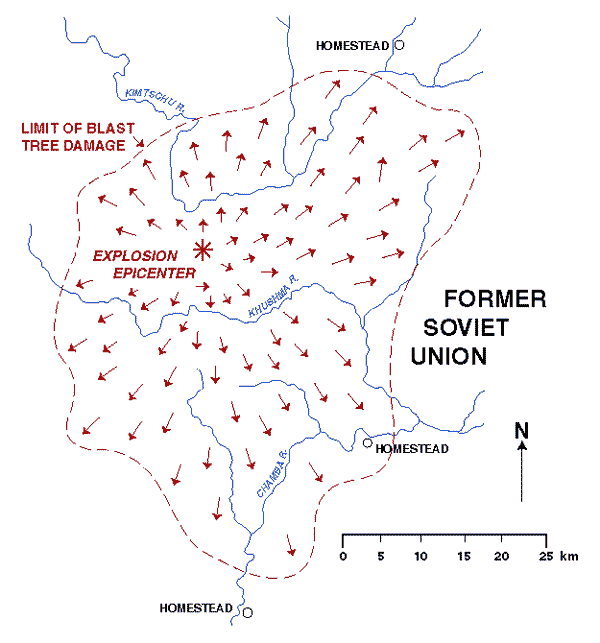(Post updated 2/19/2013 with latest assessment on asteroid from ESA.)
Wow! Two wake up calls for the planet Earth in one day! Maybe it’s about time that the people of planet Earth realize that they are inside the pinball machine that makes up our Solar System. Sooner or later that ball is going to hit us head on. Today we were lucky – twice!

Russian Meteor, February 15, 2013
The spectacular meteor that streaked across Russia’s sky Friday morning has been estimated to be about 56 feet (17 meters) across, weighing in at more than 7000 metric tons and moving at speed around 40,000 mph (64, 373 km/h). It exploded about 9-12 miles (15-20 km) above the surface of the Earth with an equivalent of 500 kilotons of TNT—30 times the energy of the Hiroshima atomic bomb. The consequent shockwave shattered windows and damage buildings in and around the Russian city, Chelyabinsk, resulting in over 1000 injuries.
This meteor was not related to the flyby later in the day of asteroid 2012 DA14. This asteroid skimmed by the Earth at a distance a little over 17,000 miles (27,400 km). Friday, February 15, 2013 could have turned out a lot different if either of these cosmic messengers had a slight change in course, which in the case of the Russian asteroid, could have detonated lower and over a more populated area or for 2012 DA14, a direct hit instead of a near miss.
We have two good examples of the consequences of an asteroid the size of 2012 DA14 (150 feet, 45 meters, ~130,000 metric tons) hitting the Earth in the Tunguska explosion of 1908 in Siberia (120 feet, 37 meters, ~100,000 metric tons) and the nickel-iron meteor (150 feet, 50 meters, ~270,000 metric tons) responsible for Meteor Crater in Arizona.
The Tunguska explosion occurred in the air above Siberia at a height of about 28,000 feet
(8500 meters) and generated the equivalent energy of about 1000 Hiroshima atomic bombs. The result was over 800 square miles of forest destroyed and a shock waves that
were recorded as far as western Europe and registered a magnitude 5 earthquake. As of today, no crater has been found to mark an impact of the remnants of the asteroid, leading some to think it might have been piece of a comet that entered Earth’s atmosphere that day, which is made mostly of ice.
Contrasting Tunguska is the nickel-iron meteor that did leave a crater in what is now Arizona. About 50,000 years ago this meteor entered the atmosphere at a speed of about 27,000 mph (43,000 km/hr) and fragmented to some degree due to the stresses associated with entry into the atmosphere, but the bulk of it hit the Earth creating a crater that is 4000 feet (1200 meters) in diameter and 570 feet (174 meters) deep. The explosive energy released from the impact has been estimated to be as high as 200 times that of the bomb dropped on Hiroshima.
We see two very different effects from two similarly sized asteroids. But, it is the different composition that makes the difference. The high density nickel-iron meteor survives the descent to the surface, while the less dense, ice-rich meteor fragments due to the high stresses experienced in its passage through thicker layers of the atmosphere. The temperatures experienced by these fragments can reach 45,000 °F (25,000 °C) causing the massive fireball and resulting shockwave and destruction.
We don’t, by any stretch of the imagination have knowledge of every asteroid in the Solar System that poses a potential threat to Earth. The more we look the more we see, and with regard to near Earth asteroids (NEA), the sooner we find them the better. It is possibly the only natural disaster we may be able to avert, given enough time.
Till next time,
RC Davison
References:
Russian asteroid impact ESA update and assessment
The Tunguska Impact – 100 Years Later
Damage by Impact — the Case at Meteor Crater, Arizona
Barringer Meteor Crater and Its Environmental Effects




Great article, really informative and with the comparisons to Hiroshima, really scary. I thought there was a system in place which was supposed to be monitoring asteroids. Was it known these asteroids were on their way?
There are several systems and surveys in place that are searching for new asteroids like the new Pan-STARRS telescope, a lot of them are conducted by highly skilled amateur astronomers. More is needed and a serious effort needs to be put forth and government funded to develop methods to divert an asteroid heading toward Earth.
Asteroid 2012 DA14 was discovered last year, but it was more by chance that it was detected. It’s high speed required a faster CCD camera to pick it up and a group funded by the Planetary Society had the right equipment at the right time to detect it. The Russian asteroid was totally unknown, and it being smaller it would be that much more difficult to detect.
Thanks,
RC Davsion